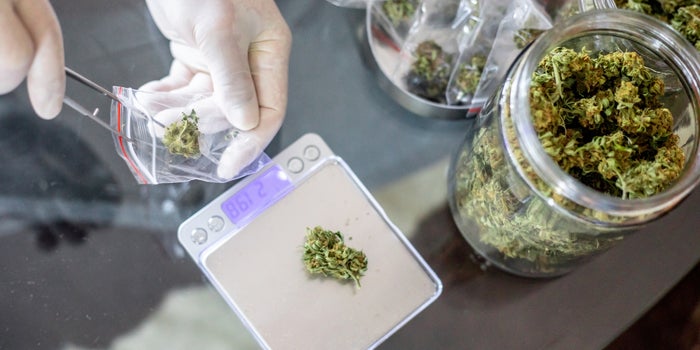Cannabis Packages Adapt to Consumer Preference

As cannabis continues to grow in legality for both medicinal and adult-use, consumers have indicated changing parameters for which format they prefer, with concentrates and edibles muscling in on dried flowers stronghold.
In 2017, dried flower represented a full 50 percent of the entire U.S. cannabis market, but this market share dropped to 36 percent by 2019, according to PMMI’s report Cannabis Market Update: Unique Challenges for THC and CBD Products. The decline in dried flower coincided with significant gains in other formats with concentrates expanding by 13 percent to reach 36 percent of market share. Edibles also grew slightly in the same period, from 12 percent market share to 14 percent.
The “other” category of cannabis products grew the most, per PMMI’s update, with a diverse set of formats such as creams, gels, dried teas/powders and inhalers more than doubling, from 15 percent in 2017 to 36 percent in 2019.
When selecting cannabis packaging, the first — somewhat obvious — factor to consider is the cannabis product format to determine what type of packaging is most suitable. While data for packaging formats of cannabis products is difficult to nail down, a few basic styles remain preferable for some of the largest cannabis categories.
While dried flower is most commonly placed by hand into a plastic jar with a child-resistant lid, small cups with child-resistant lids are the preferred packaging format for concentrates. While plastic cups were popular in the early days of cannabis sales, many producers have migrated to small glass cups. In addition to cups, concentrates are also commonly packaged in needleless syringes, allowing for easy metering of doses. Concentrates as additives to food and beverage are packaged in small glass bottles with a dropper top. Many brands in the concentrate market are also placing vape cartridges into a blister, pill bottle or a pop-top container to meet regulatory requirements.
When it comes to edibles, there is no set standard for packaging. Since edibles now span just about every type of snack food and beverage imaginable, the packaging formats they come in are varied and diverse: conventional glass, plastic jars, flexible pouches and aluminum bottles. In general, the edibles market has seen growth in flexible packaging for both convenience and environmental concerns. Packaging such as flexible bags also helps cannabis brands stand out from the competition by conveying a more premium aesthetic look to customers.
Creams, balms and salves also have a few packaging formats greatly preferred by the cannabis industry. The vast majority of packaging for these cannabis products is either plastic or glass child-resistant jars, with secondary packaging consisting of a paperboard box. Flexible tubes have also proven to be a popular packaging style for these cannabis formats, particularly in the retail setting for CBD products.
The medical cannabis market presents a different packaging challenge. The standard push-and-twist amber pill bottle ubiquitous in the pharmaceutical industry is still a popular format for medical cannabis packaging, as branding and shelf appeal are less of a concern. But, as with all plastic packaging during the sustainability era, there is growing concern about the environmental impact of plastic bottles in general. Some medical cannabis packagers are exploring flexible pouches and bags made from environmentally friendly materials.
Peel-and-push blisters, which originated in the pharma industry, have also proved to be a ready-made packaging solution for the medical cannabis market, since these packages already meet requirements for child-resistant packaging. While effective, these blisters are more expensive per unit and require investing in a machine capable of producing them or using a contract packager.
420 Intel is Your Source for Marijuana News
420 Intel Canada is your leading news source for the Canadian cannabis industry. Get the latest updates on Canadian cannabis stocks and developments on how Canada continues to be a major player in the worldwide recreational and medical cannabis industry.
420 Intel Canada is the Canadian Industry news outlet that will keep you updated on how these Canadian developments in recreational and medical marijuana will impact the country and the world. Our commitment is to bring you the most important cannabis news stories from across Canada every day of the week.
Marijuana industry news is a constant endeavor with new developments each day. For marijuana news across the True North, 420 Intel Canada promises to bring you quality, Canadian, cannabis industry news.
You can get 420 Intel news delivered directly to your inbox by signing up for our daily marijuana news, ensuring you’re always kept up to date on the ever-changing cannabis industry. To stay even better informed about marijuana legalization news follow us on Twitter, Facebook and LinkedIn.




